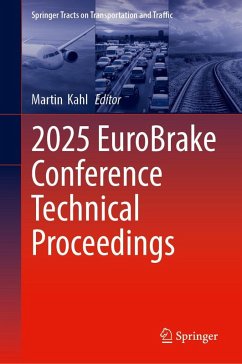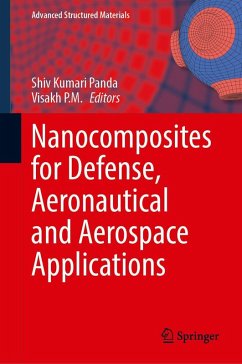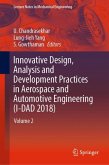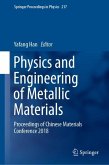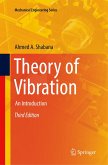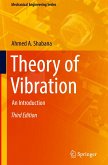2025 EuroBrake Conference Technical Proceedings
Herausgegeben:Kahl, Martin
2025 EuroBrake Conference Technical Proceedings
Herausgegeben:Kahl, Martin
- Gebundenes Buch
- Merkliste
- Auf die Merkliste
- Bewerten Bewerten
- Teilen
- Produkt teilen
- Produkterinnerung
- Produkterinnerung
This book contains proceedings of Eurobrake 2025, the world's leading event serving the brake and friction technical community.
EuroBrake was established in 2012, to create a high profile, annual technical conference and leadership event for the brake and friction technical community. It is the annual opportunity for the world's brake and friction technology community to come together in the pursuit of technological advancement, knowledge share, corporate visibility and networking with its international peer group.
Now entering its thirteenth year EuroBrake is now established as the…mehr
Andere Kunden interessierten sich auch für
![Nanocomposites for Defense, Aeronautical and Aerospace Applications Nanocomposites for Defense, Aeronautical and Aerospace Applications]() Nanocomposites for Defense, Aeronautical and Aerospace Applications136,99 €
Nanocomposites for Defense, Aeronautical and Aerospace Applications136,99 €![High-Performance Textile Composites High-Performance Textile Composites]() High-Performance Textile Composites127,99 €
High-Performance Textile Composites127,99 €![Innovative Design, Analysis and Development Practices in Aerospace and Automotive Engineering (I-DAD 2018) Innovative Design, Analysis and Development Practices in Aerospace and Automotive Engineering (I-DAD 2018)]() Innovative Design, Analysis and Development Practices in Aerospace and Automotive Engineering (I-DAD 2018)174,99 €
Innovative Design, Analysis and Development Practices in Aerospace and Automotive Engineering (I-DAD 2018)174,99 €![Innovative Design, Analysis and Development Practices in Aerospace and Automotive Engineering (I-DAD 2018) Innovative Design, Analysis and Development Practices in Aerospace and Automotive Engineering (I-DAD 2018)]() Innovative Design, Analysis and Development Practices in Aerospace and Automotive Engineering (I-DAD 2018)151,99 €
Innovative Design, Analysis and Development Practices in Aerospace and Automotive Engineering (I-DAD 2018)151,99 €![Physics and Engineering of Metallic Materials Physics and Engineering of Metallic Materials]() Physics and Engineering of Metallic Materials167,99 €
Physics and Engineering of Metallic Materials167,99 €![Theory of Vibration Theory of Vibration]() Ahmed A. ShabanaTheory of Vibration68,99 €
Ahmed A. ShabanaTheory of Vibration68,99 €![Theory of Vibration Theory of Vibration]() Ahmed A. ShabanaTheory of Vibration83,99 €
Ahmed A. ShabanaTheory of Vibration83,99 €-
-
-
This book contains proceedings of Eurobrake 2025, the world's leading event serving the brake and friction technical community.
EuroBrake was established in 2012, to create a high profile, annual technical conference and leadership event for the brake and friction technical community. It is the annual opportunity for the world's brake and friction technology community to come together in the pursuit of technological advancement, knowledge share, corporate visibility and networking with its international peer group.
Now entering its thirteenth year EuroBrake is now established as the world's largest technical event of its kind, attracting 1,000 delegates, a significant technical programme of more than 100 technical presentations and 100 exhibitors representing the entire value chain. This proceedings contains high-quality content with a growing emphasis on cutting-edge research, innovative technology, and environmentally friendly materials and approaches.
EuroBrake was established in 2012, to create a high profile, annual technical conference and leadership event for the brake and friction technical community. It is the annual opportunity for the world's brake and friction technology community to come together in the pursuit of technological advancement, knowledge share, corporate visibility and networking with its international peer group.
Now entering its thirteenth year EuroBrake is now established as the world's largest technical event of its kind, attracting 1,000 delegates, a significant technical programme of more than 100 technical presentations and 100 exhibitors representing the entire value chain. This proceedings contains high-quality content with a growing emphasis on cutting-edge research, innovative technology, and environmentally friendly materials and approaches.
Produktdetails
- Produktdetails
- Springer Tracts on Transportation and Traffic 23
- Verlag: Springer, Berlin; Springer
- Artikelnr. des Verlages: 89554762
- Seitenzahl: 327
- Erscheinungstermin: 22. Februar 2026
- Englisch
- Abmessung: 235mm x 155mm
- ISBN-13: 9783032106872
- ISBN-10: 3032106877
- Artikelnr.: 75571495
- Herstellerkennzeichnung
- Springer-Verlag GmbH
- Tiergartenstr. 17
- 69121 Heidelberg
- ProductSafety@springernature.com
- Springer Tracts on Transportation and Traffic 23
- Verlag: Springer, Berlin; Springer
- Artikelnr. des Verlages: 89554762
- Seitenzahl: 327
- Erscheinungstermin: 22. Februar 2026
- Englisch
- Abmessung: 235mm x 155mm
- ISBN-13: 9783032106872
- ISBN-10: 3032106877
- Artikelnr.: 75571495
- Herstellerkennzeichnung
- Springer-Verlag GmbH
- Tiergartenstr. 17
- 69121 Heidelberg
- ProductSafety@springernature.com
All credit for the works contained in this publication is due to the contributors to the 2025 EuroBrake conference. This publication has been edited by Martin Kahl, Chief Technology Officer at FISITA, with oversight and input from FISITA colleagues and the EuroBrake Steering Committee and reviewing team.
Chapter 1
Development of 2
Piston MoC Brake System for Heavy Duty Pick
up Truck.
Chapter 2
Development of Drum EPB Brake System for Passenger Vehicle.
Chapter 3
Simulative potential analysis of brake
by
wire systems for integrated chassis control strategies and software
defined vehicles.
Chapter 4
Design and preliminary experimental tests of an innovative test bench for zero emission braking system.
Chapter 5
Brake System Durability Testing Using Virtual Test Markets: A new approach to simulate mission related usage variabilities.
Chapter 6
Evaluating the velocity field in the wake of a brake caliper with optical measurement technique (PIV, Particle Image Velocimetry).
Chapter 7
Regenerative Braking strategies in EVs: the balance between efficiency, stability, and right
sizing.
Chapter 8
Braking performance comparison of hybrid SE
MR drum brake and CE
MR drum brake.
Chapter 9
Navigating the Braking Paradigm Shift: Challenges and Opportunities in Commercial Vehicle Conversions from ICE to Fuel Cell EV.
Chapter 10
Assessing brake wear particle emissions and performance of FNC
Smart ONC GCI Rotors for Euro 7 Compliance.
Chapter 11
Niobium Alloyed Ferritic Nitrocarburized Brake Disc.
Chapter 12
A quantitative approach to understand the relationship between disc homogeneity and brake judder.
Chapter 13
A Good Control of the Microstructure as a Potential Tool to Improve Wear Behavior of Hypereutectic Grey Cast Iron.
Chapter 14
A New Potassium Hexatitanate.
Chapter 15
Methodology for generation, collection and analysis of primary data for tyre airborne emission factors.
Chapter 16
How effective is the collection of particles for reducing the non
exhaust emission footprint of road transport? An LCA and CBA analysis for EU light
duty vehicles and fleets.
Chapter 17
Identifying Critical Operational Conditions Using Statistical Distributions and Complex Eigenvalue Analysis in S
Cam Drum Brakes..
Chapter 18
CFD Simulation of BPE on a Drum Brake.
Chapter 19
Development of a Method for optimizing Route Planning with regard to Non
Exhaust Emissions.
Chapter 20
Thermal Modelling of a Drum Brake: A Multi
Point
Mass Approach.
Chapter 21
Development of Driver Model for real
time simulation of brake control systems.
Chapter 22
Parameterization of a Detailed Vehicle Model based on Basic Parameters.
Chapter 23
A complete forming processes simulation methodology for mechatronic braking component..
Chapter 24
Brake Cooling Optimization using AI: A Case Study on Audi SUVs.
Chapter 25
Experimental and Analytical Investigation on Automotive Disc Brake Hot Judder Studied as a Self
Excited Vibration with Time Delay.
Chapter 26
Investigation of Brake Pad Deformation Under Pressure.
Chapter 27
Analysis of possible brake emission test for HDVs.
Chapter 28
Enhancing Vehicle Roadworthiness Inspections: Integrating Brake Pressure Manipulation and Deep Learning for Advanced Brake Performance Analysis of Hydraulic Braked Vehicles.
Chapter 29
Measurement and characterization of brake particle emissions of a passenger car in extended range of driving conditions.
Chapter 30
Comparison of TRWP emission behaviour in real driving scenarios of light duty vehicles and heavy duty vehicles.
Chapter 31
Considerations on Damping Shim Adhesive Bleeding under EPB Loading.
Development of 2
Piston MoC Brake System for Heavy Duty Pick
up Truck.
Chapter 2
Development of Drum EPB Brake System for Passenger Vehicle.
Chapter 3
Simulative potential analysis of brake
by
wire systems for integrated chassis control strategies and software
defined vehicles.
Chapter 4
Design and preliminary experimental tests of an innovative test bench for zero emission braking system.
Chapter 5
Brake System Durability Testing Using Virtual Test Markets: A new approach to simulate mission related usage variabilities.
Chapter 6
Evaluating the velocity field in the wake of a brake caliper with optical measurement technique (PIV, Particle Image Velocimetry).
Chapter 7
Regenerative Braking strategies in EVs: the balance between efficiency, stability, and right
sizing.
Chapter 8
Braking performance comparison of hybrid SE
MR drum brake and CE
MR drum brake.
Chapter 9
Navigating the Braking Paradigm Shift: Challenges and Opportunities in Commercial Vehicle Conversions from ICE to Fuel Cell EV.
Chapter 10
Assessing brake wear particle emissions and performance of FNC
Smart ONC GCI Rotors for Euro 7 Compliance.
Chapter 11
Niobium Alloyed Ferritic Nitrocarburized Brake Disc.
Chapter 12
A quantitative approach to understand the relationship between disc homogeneity and brake judder.
Chapter 13
A Good Control of the Microstructure as a Potential Tool to Improve Wear Behavior of Hypereutectic Grey Cast Iron.
Chapter 14
A New Potassium Hexatitanate.
Chapter 15
Methodology for generation, collection and analysis of primary data for tyre airborne emission factors.
Chapter 16
How effective is the collection of particles for reducing the non
exhaust emission footprint of road transport? An LCA and CBA analysis for EU light
duty vehicles and fleets.
Chapter 17
Identifying Critical Operational Conditions Using Statistical Distributions and Complex Eigenvalue Analysis in S
Cam Drum Brakes..
Chapter 18
CFD Simulation of BPE on a Drum Brake.
Chapter 19
Development of a Method for optimizing Route Planning with regard to Non
Exhaust Emissions.
Chapter 20
Thermal Modelling of a Drum Brake: A Multi
Point
Mass Approach.
Chapter 21
Development of Driver Model for real
time simulation of brake control systems.
Chapter 22
Parameterization of a Detailed Vehicle Model based on Basic Parameters.
Chapter 23
A complete forming processes simulation methodology for mechatronic braking component..
Chapter 24
Brake Cooling Optimization using AI: A Case Study on Audi SUVs.
Chapter 25
Experimental and Analytical Investigation on Automotive Disc Brake Hot Judder Studied as a Self
Excited Vibration with Time Delay.
Chapter 26
Investigation of Brake Pad Deformation Under Pressure.
Chapter 27
Analysis of possible brake emission test for HDVs.
Chapter 28
Enhancing Vehicle Roadworthiness Inspections: Integrating Brake Pressure Manipulation and Deep Learning for Advanced Brake Performance Analysis of Hydraulic Braked Vehicles.
Chapter 29
Measurement and characterization of brake particle emissions of a passenger car in extended range of driving conditions.
Chapter 30
Comparison of TRWP emission behaviour in real driving scenarios of light duty vehicles and heavy duty vehicles.
Chapter 31
Considerations on Damping Shim Adhesive Bleeding under EPB Loading.
Chapter 1
Development of 2
Piston MoC Brake System for Heavy Duty Pick
up Truck.
Chapter 2
Development of Drum EPB Brake System for Passenger Vehicle.
Chapter 3
Simulative potential analysis of brake
by
wire systems for integrated chassis control strategies and software
defined vehicles.
Chapter 4
Design and preliminary experimental tests of an innovative test bench for zero emission braking system.
Chapter 5
Brake System Durability Testing Using Virtual Test Markets: A new approach to simulate mission related usage variabilities.
Chapter 6
Evaluating the velocity field in the wake of a brake caliper with optical measurement technique (PIV, Particle Image Velocimetry).
Chapter 7
Regenerative Braking strategies in EVs: the balance between efficiency, stability, and right
sizing.
Chapter 8
Braking performance comparison of hybrid SE
MR drum brake and CE
MR drum brake.
Chapter 9
Navigating the Braking Paradigm Shift: Challenges and Opportunities in Commercial Vehicle Conversions from ICE to Fuel Cell EV.
Chapter 10
Assessing brake wear particle emissions and performance of FNC
Smart ONC GCI Rotors for Euro 7 Compliance.
Chapter 11
Niobium Alloyed Ferritic Nitrocarburized Brake Disc.
Chapter 12
A quantitative approach to understand the relationship between disc homogeneity and brake judder.
Chapter 13
A Good Control of the Microstructure as a Potential Tool to Improve Wear Behavior of Hypereutectic Grey Cast Iron.
Chapter 14
A New Potassium Hexatitanate.
Chapter 15
Methodology for generation, collection and analysis of primary data for tyre airborne emission factors.
Chapter 16
How effective is the collection of particles for reducing the non
exhaust emission footprint of road transport? An LCA and CBA analysis for EU light
duty vehicles and fleets.
Chapter 17
Identifying Critical Operational Conditions Using Statistical Distributions and Complex Eigenvalue Analysis in S
Cam Drum Brakes..
Chapter 18
CFD Simulation of BPE on a Drum Brake.
Chapter 19
Development of a Method for optimizing Route Planning with regard to Non
Exhaust Emissions.
Chapter 20
Thermal Modelling of a Drum Brake: A Multi
Point
Mass Approach.
Chapter 21
Development of Driver Model for real
time simulation of brake control systems.
Chapter 22
Parameterization of a Detailed Vehicle Model based on Basic Parameters.
Chapter 23
A complete forming processes simulation methodology for mechatronic braking component..
Chapter 24
Brake Cooling Optimization using AI: A Case Study on Audi SUVs.
Chapter 25
Experimental and Analytical Investigation on Automotive Disc Brake Hot Judder Studied as a Self
Excited Vibration with Time Delay.
Chapter 26
Investigation of Brake Pad Deformation Under Pressure.
Chapter 27
Analysis of possible brake emission test for HDVs.
Chapter 28
Enhancing Vehicle Roadworthiness Inspections: Integrating Brake Pressure Manipulation and Deep Learning for Advanced Brake Performance Analysis of Hydraulic Braked Vehicles.
Chapter 29
Measurement and characterization of brake particle emissions of a passenger car in extended range of driving conditions.
Chapter 30
Comparison of TRWP emission behaviour in real driving scenarios of light duty vehicles and heavy duty vehicles.
Chapter 31
Considerations on Damping Shim Adhesive Bleeding under EPB Loading.
Development of 2
Piston MoC Brake System for Heavy Duty Pick
up Truck.
Chapter 2
Development of Drum EPB Brake System for Passenger Vehicle.
Chapter 3
Simulative potential analysis of brake
by
wire systems for integrated chassis control strategies and software
defined vehicles.
Chapter 4
Design and preliminary experimental tests of an innovative test bench for zero emission braking system.
Chapter 5
Brake System Durability Testing Using Virtual Test Markets: A new approach to simulate mission related usage variabilities.
Chapter 6
Evaluating the velocity field in the wake of a brake caliper with optical measurement technique (PIV, Particle Image Velocimetry).
Chapter 7
Regenerative Braking strategies in EVs: the balance between efficiency, stability, and right
sizing.
Chapter 8
Braking performance comparison of hybrid SE
MR drum brake and CE
MR drum brake.
Chapter 9
Navigating the Braking Paradigm Shift: Challenges and Opportunities in Commercial Vehicle Conversions from ICE to Fuel Cell EV.
Chapter 10
Assessing brake wear particle emissions and performance of FNC
Smart ONC GCI Rotors for Euro 7 Compliance.
Chapter 11
Niobium Alloyed Ferritic Nitrocarburized Brake Disc.
Chapter 12
A quantitative approach to understand the relationship between disc homogeneity and brake judder.
Chapter 13
A Good Control of the Microstructure as a Potential Tool to Improve Wear Behavior of Hypereutectic Grey Cast Iron.
Chapter 14
A New Potassium Hexatitanate.
Chapter 15
Methodology for generation, collection and analysis of primary data for tyre airborne emission factors.
Chapter 16
How effective is the collection of particles for reducing the non
exhaust emission footprint of road transport? An LCA and CBA analysis for EU light
duty vehicles and fleets.
Chapter 17
Identifying Critical Operational Conditions Using Statistical Distributions and Complex Eigenvalue Analysis in S
Cam Drum Brakes..
Chapter 18
CFD Simulation of BPE on a Drum Brake.
Chapter 19
Development of a Method for optimizing Route Planning with regard to Non
Exhaust Emissions.
Chapter 20
Thermal Modelling of a Drum Brake: A Multi
Point
Mass Approach.
Chapter 21
Development of Driver Model for real
time simulation of brake control systems.
Chapter 22
Parameterization of a Detailed Vehicle Model based on Basic Parameters.
Chapter 23
A complete forming processes simulation methodology for mechatronic braking component..
Chapter 24
Brake Cooling Optimization using AI: A Case Study on Audi SUVs.
Chapter 25
Experimental and Analytical Investigation on Automotive Disc Brake Hot Judder Studied as a Self
Excited Vibration with Time Delay.
Chapter 26
Investigation of Brake Pad Deformation Under Pressure.
Chapter 27
Analysis of possible brake emission test for HDVs.
Chapter 28
Enhancing Vehicle Roadworthiness Inspections: Integrating Brake Pressure Manipulation and Deep Learning for Advanced Brake Performance Analysis of Hydraulic Braked Vehicles.
Chapter 29
Measurement and characterization of brake particle emissions of a passenger car in extended range of driving conditions.
Chapter 30
Comparison of TRWP emission behaviour in real driving scenarios of light duty vehicles and heavy duty vehicles.
Chapter 31
Considerations on Damping Shim Adhesive Bleeding under EPB Loading.

